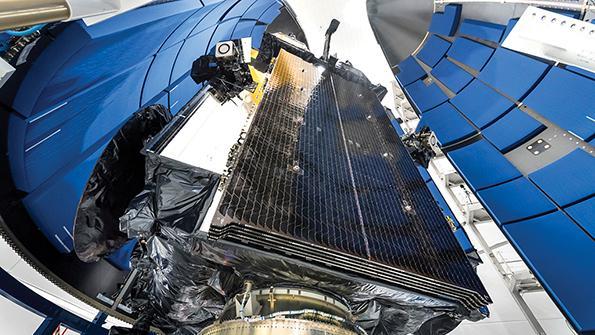Space Force Budget Request Invests Heavily In Resilient Sats Research

The Pentagon’s fiscal 2023 budget request, released March 28, is the first time the U.S. Space Force has been able to plan spending as its own independent service, and the result is a big investment in research and development aimed at making key capabilities in orbit better protected from emerging threats.
The Space Force is requesting $24.5 billion for its slice of the 2023 budget, and of that amount, 65% ($15.8 billion) is focused on research, development, test and evaluation (RDT&E). Another $3.6 billion is earmarked for procurement, and for the first time the service would have its own personnel appropriations with about $1 billion going to pay for its people.
The large slice of research spending is in recognition of real threats from China and Russia to U.S. satellites in all orbital regimes, Air Force Secretary Frank Kendall says.
“Our general posture has been to assume essentially impunity in space, so we can put up expensive systems in small numbers and not worry too much about how they’re being attacked,” Kendall says. “That era is over. And it’s been over for a while now. So, this is a move toward systems that could continue to provide the services we depend upon, and there’s no more important services than missile warning and nuclear command and control.”
Specific RDT&E spending in the request includes:
• $3.479 billion for Overhead Persistent Infrared programs, up from $2.451 billion in the 2022 request. This includes ground and geosynchronous space segments of the next-generation OPIR missile warning and tracking system, according to Maj. Gen. James Peccia, the deputy assistant secretary for budget.
• $1.03 billion for Resilient Missile Warning and Missile Tracking, a new start. This spending would be part of the broader pivot to a more resilient, multi-orbit architecture, Peccia says.
• $987 million for Space Technology Development and Prototyping for missile warning and missile tracking, a transfer from the Space Development Agency.
• $556 million for Evolved Strategic Satellite Communications, up from $150 million in the fiscal 2022 request. This would replace an Advanced Extremely High Frequency satellite for secure survivable communications used for nuclear command and control and presidential and senior leader aircraft.
• $461 million for Space Science and Technology Research and Development, another transfer from the Space Development Agency. This spending would be on research and development for data transport, Peccia says.
• $231 million for a Deep Space Advanced Radar Capability, up from $123 million in the 2022 request. This spending would stand up a first prototype site to provide an all-weather look into geosynchronous orbit, Peccia says.
• $121 million for Protected Tactical Enterprise Services, up from $100 million last year. This focuses on anti-jamming performance for global satellites and helping secure satellite communications, Peccia says.
“You’ll see significant investment as the Space Force pivots to an architecture that is much more resilient, survivable and defendable,” Air Force Under Secretary Gina Ortiz-Jones says.
For procurement, the Space Force wants to spend $1.1 billion for national security space launches and $314 million for three Space Development Agency launches, along with two GPS III follow-on satellites.
In the operations and maintenance budget, the Space Force is requesting $67 million to bring its six Deltas up to full capacity and wants to spend $18 million on commercial data for space domain awareness.
